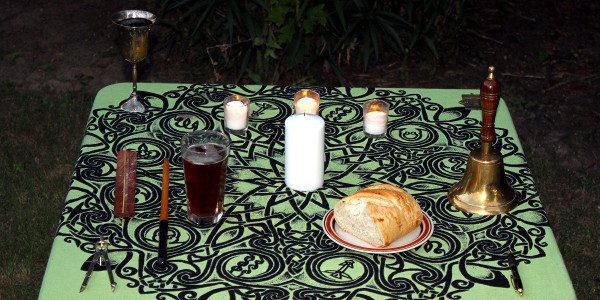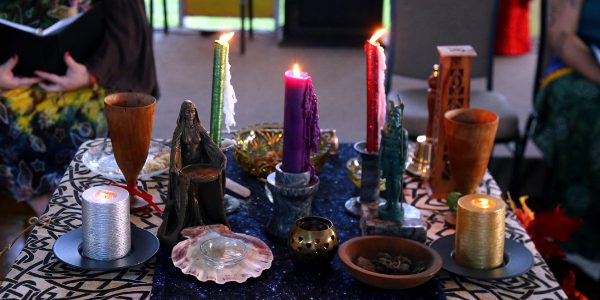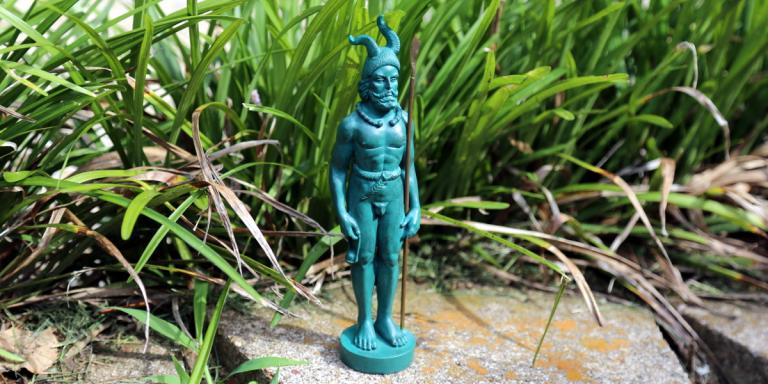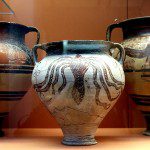It’s still June and the Summer Solstice is less than a week in the past, but it’s time to move on to the season of Lughnasadh. And this year, I’m feeling a sense of urgency from the Master of All Arts.
The Solitary Ritual Series has been a very good thing for this blog, and for the many Pagans and other folks who read – and presumably, perform – them. As each high day approaches, I see blog traffic increase, sometimes dramatically. I exclude the solitary rituals from my Top 10 Posts of the Year feature each December, but if I didn’t three of them would have been on last year’s list (Samhain, Summer Solstice, and Imbolc). Two more (Ostara and Beltane) were in the Top 20.
Lughnasadh was #53.

The difference is even more dramatic when you look at total views for the life of the post. The most widely read of the eight rituals is Samhain with 23,744 views as I write this. Lughnasadh is in last place with 4,237. I can’t blame it on Google – when I search for “Lughnasadh ritual” it comes up #2 and when I search for “Lughnasadh solitary ritual” it comes up #1.
I know some Pagans spell it Lughnassa and some call it Lammas – that would impact the traffic from Google. But this isn’t just a blog traffic thing – the high day itself isn’t particularly well observed.
It’s at the first of August when lots of people are on vacation, and school kids and teachers are trying to cram as much as they can into what’s left of their breaks. It may be the first harvest, but few of us have any real connection with agricultural cycles. And it’s hot. On average, August 1 is the hottest day of the year in Dallas – Fort Worth, with an average high of 97 and an average low of 76.
Jason Mankey calls Lughnasadh “the ugly-duckling of sabbats.”
Denton CUUPS abandoned Lughnasadh for three years. In 2013 we used the August 1 high day for our first Cernunnos Ritual. In 2014 a Hellenic member led a Rite of Herakles, and in 2015 we performed a Ritual of Hermes. Last year I got the strong message “I want my festival back.” And so we did.

Alas, I won’t be there for this year’s Lughnasadh. I’ll be in Houston for a workshop and book signing at Pixie’s Intent on July 29, then speaking at the Unitarian Fellowship of Houston the following Sunday morning. But I will pour offerings to Lugh on my own on August 1.
Lugh was the first God I got to know as an individual being. Before that, most of my practice revolved around the Wiccan idea of the Goddess and the God, or other concepts that some would describe as panentheist and others would describe as vague. This was before my encounter with the Ennead of Egypt that put me firmly on the road to polytheism, and I honestly don’t remember what I thought about Lugh. But I clearly remember how I related to Lugh – as an individual deity with his own sovereignty and agency.
Did Lugh call me or did I pursue Lugh? My notes from the time are sparse and I can’t begin to remember. I just remember I felt a strong affinity with him. I am no Master of All Arts, but I’ve always had a wide range of interests, and Lugh seemed like he would be the perfect patron for me. My early work with and for him was helpful to me, and presumably to him as well (if he had any complaints, I never felt or heard them).
Then Cernunnos re-emerged in my life and my direction changed dramatically. I continued to honor Lugh at Lughnasadh, but other than that he faded into the background.
I had a wonderful experience of Lugh at the 2010 House of Danu Gorsedd. Thorn Coyle led a workshop on ecstatic ritual that turned into the preparation for the main Lughnasadh rite. That was the most intimate and powerful ritual I had experienced at the time.
I’ve had more recent experiences of Lugh that were quite powerful. Those are not yet ready to be shared. But what needs to be shared are Lugh’s stories, and there are several, including the story of his birth. This version is adapted from Gods and Fighting Men by Lady Augusta Gregory.
A long time ago the Fomorians controlled Ireland, and their king was Balor of the Evil Eye, so called because anyone who looked at his eye would immediately die. A Druid had prophesied that Balor would be killed by his own grandson, so he took his only child, a daughter named Ethniu, and locked her up in a tower guarded by twelve women, so she would never see or hear a man. But Ethniu often dreamed of a man.
At this same time there were three brothers living across the sea, and they were men of the Tuatha De Danann. They names were Samthainn, Cian, and Goibniu the famous smith. Now Cian had a great cow who never failed to give milk. Many people wanted this cow, so that she had to be watched night and day or someone would steal her.
Now Cian and Samthainn wanted swords made, so they went to Goibniu’s forge, and Cian brought the cow with him for safekeeping. When they arrived, Cian asked his brother Samthainn to hold the cow while he went into the forge to speak with Goibniu.
Now Balor wanted this cow badly, and he was watching. When he saw Samthainn holding the cow, he made himself look like a little boy, and went up to Samthainn and said “your brothers are going to use all the good steel for their swords, and make yours out of plain iron.”
Samthainn was outraged. “They will not deceive me so easily. Hold the cow, boy.” He rushed into the forge, and no sooner did Balor get the halter in his hand than he set out, dragging the cow along with him to his boat, and them across the sea to his palace.
When Cian saw his brother coming in he rushed out, and he saw Balor and the cow in the boat, on the water. There was nothing he could do to get his cow back.
So Cian went to a female Druid named Birog. She dressed him in women’s clothes, and sent him across the sea in a great gust of wind, to the tower where Ethniu was. Then she called to the women in the tower “Grant me shelter, good ladies, for I am traveling with a queen of the Tuatha De Danann, and this storm is great.” The Fomorian women did not like to refuse a woman of the Tuatha De Danann, so they let them in.
Then Birog cast an enchantment, and all the Fomorian women fell asleep. Cian went to speak with Ethniu, and when she saw him she said “you are the man of whom I have dreamt” and she gave him her love. After a while Birog and Cian went away on another great gust of wind.
And when her time came, Ethniu gave birth to a son. When Balor found out, he had his people put the child in a cloth and fasten it with a pin and throw him into the sea. As they were carrying the child across an arm of the sea, the pin dropped out, and the child slipped from the cloth into the water, and they thought he was drowned.
But the Druid Birog pulled him to her, and she brought him to his father Cian, who gave him to Tailtiu, daughter of the King of the Great Plain. And Tailtiu was his foster mother until he grew into manhood.
Hail Lugh!
The 2017 Celebration of Lugh
June 27: The Birth of Lugh
July 6: The Coming of Lugh
July 13: The Leadership of Lugh
July 20: The Victory of Lugh
From 2015: Lughnasadh – A Solitary Ritual

















